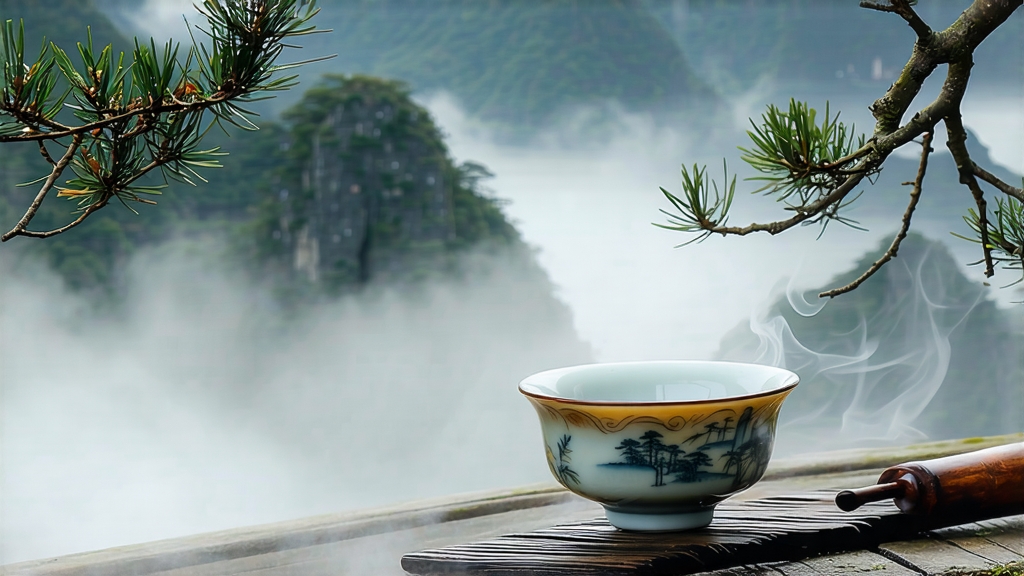
Long before English merchants coined the term “black tea,” the mountain villagers of Tongmu in China’s Wuyi range were already firing fresh leaves over smoldering pine logs. The result—Lapsang Souchong—became the first fully oxidized tea ever documented, the prototype for every subsequent black tea on earth. Today its sweet, resinous perfume still drifts across the narrow stone alleys of Tongmu, a protected enclave where only a handful of families retain the right to produce the authentic leaf. For international drinkers who know it only as a smoky ingredient in Russian Caravan blends, the original craft version is a revelation: silky, wine-like, with a scent that oscillates between longan fruit and a distant winter hearth.
History: From Ming Border Guards to London Parlors
Legend places the birth of Lapsang Souchong in 1646, when Qing army units passed through Tongmu during the Ming-Qing transition. To dry the tea quickly for transport, soldiers spread leaves on pine racks above campfires. The accidental smoke infusion proved popular with the Dutch traders who first carried it to Europe; by 1669 the British East India Company listed “Bohea Souchong” at prices higher than green tea. Catherine of Braganza’s marriage to Charles II popularized the tea in court, and soon smoky Lapsang sailed up the Thames in lead-lined chests. The name itself encodes its origin: “souchong” refers to the fourth and fifth leaves—larger, tougher, and more aromatic than the prized buds used for green tea—while “Lapsang” is the romanization of Lapu Mountain, the core micro-zone inside Tongmu.
Terroir: Why Only 64 Square Kilometers Matter
Tongmu sits in a granite gorge at 27° N latitude, where the Wuyi massif funnels humid subtropical air into a cool cloud forest. Mean annual temperature is 14 °C; morning mist lingers until noon, filtering sunlight into a soft, diffused glow. The soil is a shallow, acidic humus layered over weathered tuff, forcing tea roots to struggle and concentrate polyphenols. Crucially, the village is too high for the tea plant pest Ectropis obliqua, eliminating the need for pesticides. Chinese law recognizes Tongmu as a National Product Geographical Indication; any leaf picked outside the 64 km² boundary may be labeled “Zhengshan Xiaozhong” but not “Tongmu Lapsang,” a distinction guarded by local inspectors who DNA-test exported batches.
Cultivars: Three Bushes That Smoke Differently
- Cai Cha (Vegetable Tea): The historic poly-clonal population grown from seed. Leaves are small, pale green, and high in geraniol, yielding a light, fruity smoke reminiscent of lychee.
- Zhenghe Da Bai (Big White): A 19th-century graft that adds bulk and malt sweetness; favored for export grades because it withstands heavy smoking without turning bitter.
- Jin Guan Yin (Golden Tie-Guan-Yin): A modern hybrid introduced in 2003, rich in lactones, producing a creamy, orchid-tinged liquor that softens the pine edge into toasted marshmallow.
Craft: The Eight Stages of Pine-Fire Alchemy
- Plucking: Dawn pick of one bud with two or three leaves, dew allowed to evaporate for thirty minutes to prevent stewing.
- Withering: Leaves are laid on bamboo screens inside Qing-era lofts heated indirectly by pine charcoal; temperature climbs from 28 °C to 34 °C over eight hours, reducing moisture to 60 %.
- Rolling: A 45-minute rotary roll under 6 kg pressure ruptures cells, initiating oxidation.
- Fermentation: The rolled leaf is piled in pine-wood boxes covered with wet cloth; oxidation at 24 °C lasts 2.5–3 hours, turning the leaf a coppery mahogany.
- Pan-firing: A quick 220 °C tumble in cast-iron woks deactivates enzymes and sets the color.
- Smoking: The signature step. Fresh pine logs (Pinus massoniana) are split into 40 cm staves, ignited, then smothered to produce a cool, aromatic smoke. The tea is spread on multi-tiered bamboo trays inside a brick smokehouse for 6–8 hours; masters adjust dampers every twenty minutes to keep temperature below 80